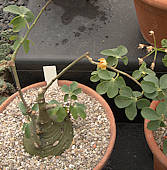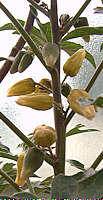Passifloraceae de Jussieu (Ex Kunth) 1817
The family Passifloraceae includes 650 species in 18 genera, of which the only succulent plants are in the genus Adenia. The remaining species include climbing vines and shrubs, of which Passiflora (Passion flowers) are widely cultivated for their large decorative flowers and fruit (granadilla).
|
Adenia Forsskål 1775
Named after: Greek aden = gland, usually found on the leaves
The genus Adenia includes around 95 species of woody trees, shrubs, herbs, and vines with swollen succulent caudiciform bases to their stems or tuberous roots. Many species have tendrils enabling them to scramble through bushes. Some are protected with thorns. Adenia are dioecious.
Cultivation: Adenia are tender plants requiring heat and full sun. These succulent plants should be watered very sparingly outside their growing season but water can be increased when the plants are in active growth. The deciduous leaves provide a guide to active and resting persiods. Compost should be gritty and free-draining, especially so for species with fleshy roots. Some species can be grown from cuttings, but these are reluctant to develop a caudex.
Some species of Adenia are used by bushmen as sources of hunting poisons and all species should be regarded as poisonous. Toxins include cyanide derivatives and potent lectins.
|
|
Adenia aculeata Engler 1881 Syn. Modecca aculeata Oliver 1880
The succulent tuber produces a branching vine up to 60ft long, scrambling through bushes assisted by tendrils from the leaf nodes or growing as an isolated stocky shrub. The thinner parts of the vine and leaves are seasonally deciduous and wild plants are leafless for much of the year. The stem may be furnished with sharp prickles. Persistent basal portions of withered tendrils also become prickles. The light green leaves have 3 - 5 lobes.
Adenia aculeata is native to Ethiopia, North-East Kenya and Somalia. Stem cuttings can be rooted but may not form a caudex. The sap is poisonous. |
|
Adenia glauca Schinz 1892 Syn. Modeca glauca
The basally-swollen, waxy green caudex grows very large, over 3ft in diameter with vining stems up to 10ft long with deciduous glaucous foliage and tendrils. Leaves have 3 - 5 lobes. The yellowish green flowers are followed by orange fruits on the female plants. Roots are fibrous and shallow.
Native to Summer rainfall parts of South Africa and Botswana, often growing between rocks. Needs a warm, dry Winter dormancy and very careful watering. Stem cuttings will grow, but probably not make a caudex. Poisonous sap.
|

Adenia globosa Engler 1891
A very large, warty, green caudex, which can grow up to 8 ft in diameter, produces a shrubby top growth of climbing, thorny green stems which are usually leafless. However, small triangular to 3-lobed leaves can be produced near the tips of the stems, with the thorns arising in the leaf axil. Flowers have 5 greenish-white petals and bright yellow stamens.
Adenia globosa is native to East Africa including Kenya, Somalia and Tanzania. The sap contains cyanogenic glycosides and is very poisonous but used in traditional medicine. This succulent plant needs warmth at all times. |
|
Adenia lobata (Jacquin) Engler 1891
Syn. Modecca lobata Jacquin 1809
This large scrambling liane with angled, knobbly stems can grow 150ft long, attaching itself by tendrils to bushes and trees for support. The shiny dark-green leaves are heart-shaped to three-lobed. The inflorescence is a cluster of 10 creamy yellow flowers.
Native to West tropical Africa including Angola, Cameroon, Ethiopea, Mozambique and Senegal.
Adenium lobata contains cyanogenic glycosides and flavanoids and is used as an arrow poison and rat poison. The entire plant is used as a fish poison. It is also widely used in traditional medicine to treat abscesses, during extraction of Guinea worms, as an enema and an aphrodisiac. The stems are used as a source of fibres and as ropes.
|
|
Adenia volkensii Harms 1895 (Kilyambiti)
The short 3 ft trunk has a succulent tuberous root and branches at the top. The dark green leaves are dissected into 3 to 7 lobes. Yellowish flowers on short, branching peduncles are produced from the leaf axils and are followed by fleshy red fruit.
Adenia volkensii is native to East Africa including Kenya and Tanzania, where it grows at elevations of up to 6000 ft. This plant contains Volkensin, a toxic ricin-like lectin. The leaves, roots and bark have traditional medicinal and veterinary uses and commercial extracts are made from the plant.
|

 Families of Succulent Plants
Families of Succulent Plants 












